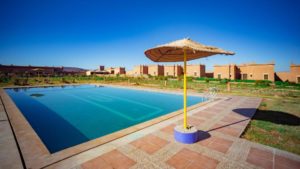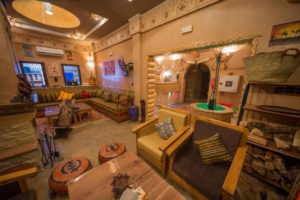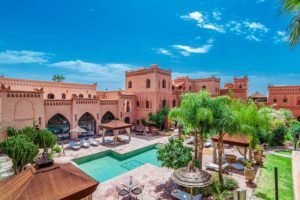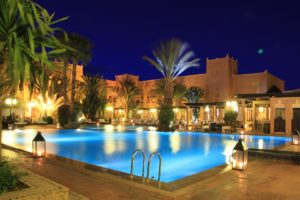- +212 698 193 183
- info@specialmorocco.com

CloseWelcome

Ouarzazate has stood at the edge of the Sahara desert for hundreds of years. A city of palm trees, sandy streets and blocky, fort-like buildings, this is the Morocco seen in a hundred movies. The name Ouarzazate comes from the Amazigh for ‘quiet place’, and compared to many of its fellow Moroccan towns and cities, there is a certain calm to be found here. Inside its walls you’ll find new hotels and complexes, plus film studios which have made the most of their photogenic location. Outside the city is the reason most people come to Ouarzazate: the stunning Sahara. Take a trek out to the nearby villages and kasbahs, see the breathtaking Todra Gorge, and marvel at one of the world’s great natural wonders.
If you’re looking for one of Ouarzazate’s cultural festivals then May is definitely the time to visit the Door of the Desert.
The first festival to look out for is The Rose Festival. Just a short drive from Ouarzazate is Kalaat M’Gouna, the rose capital of Morocco. Miles and miles of rosebushes grow around this desert oasis, a wildly colourful sight that fills the air with a heady perfume. Rosewater is highly prized throughout the kingdom (it takes 3,000 kilos of petals to make just one litre) and people celebrate the harvest with dancing and singing through the night in the souk. Through a rain of rose petals a Rose Queen is elected to reign over the crop.
And like many places in Morocco, August is the month for Moussem – Ouarzazate celebrates Sidi Daoud with a pilgrimage, a special souk for craftsmen, and plenty of song and dance.

The Door of the Desert is the place to go if you want to experience the culture of desert life. The Musee Theatre Memoire de Ouarzazate is dedicated to teaching people about, and preserving the cultural values and traditions of, the High Atlas and pre-Saharan Moroccan inhabitants. There are many exhibits here including clothes, tools and written documents that will give you a fascinating insight into these people.
Ouarzazate is in a region famous for its many kasbahs, and it’s simplicity itself to go on a tour of these fascinating buildings that were built centuries ago. It’s also a place proud of its traditions and history, and if you time your holiday correctly you’ll be able to attend one of the festivals the locals organise to celebrate their culture.

Ouarzazate, otherwise known as the Door of the Desert, connects the N9 route over the High Atlas Mountains to the Sahara. It’s the perfect place to start a cycling journey or to visit when coming over the mountains from Marrakech. On this path you get to enjoy one of the best descents Morocco has to offer down towards Ouarzazate.
In town, you will find it easy to rent a bike and excursions with a local guide into the desert or mountains are easy to book. Make sure to tour the Ksar of Aït Benhaddou, a fortress of red clay, or the Kasbah of Tifoultoute, just five miles from Ouarzazate.

The historic city of Ouarzazate, guarded by the stunning Atlas Mountains to the west and the Sahara Desert in the east, offers an adventurous range of activities and opportunities for all to enjoy in stunningly rich surroundings. Head east from Ouarzazate and you’ll soon be trekking through the deep golden sands of the Sahara, sat behind a camel’s hump, trotting along on a horse, racing on a 4×4, or sticking to the fabulous foot trails and feeling the sand beneath your soles. There are well established companies in the area which can offer you a taste of the nomadic Amazigh lifestyle, sleeping out beneath a blanket of stars, to be woken by the first golden rays of the sun hitting the dunes. The ancient Ksar of Aït Benhaddou lies nearby and as you explore it may even start to feel familiar – it’s provided the backdrop to many blockbuster films.

Take your family to Ouarzazate to enjoy some great days out. It’s not a place where you’ll find theme parks: instead, what your family will gain is a special, entirely authentic experience.
You’ll have the opportunity to spend the night in a traditional Amazigh tent surrounded by massive sand dunes, ride camels on treks into the desert and see stunning gorges and imposing mountains just minutes outside the city. Touching the modern world, Ouarzazate is also movie backdrop central. Children and adults alike will love touring Atlas Film Studios and spotting the sets and props from such films and TV shows as Game of Thrones, Atlantis, Kingdom of Heaven and Asterix and Obelix.

Sometimes known as the crossroads of the south, Ouarzazate is a place where Moroccan and Saharan culture have mixed for centuries, and the cuisine on offer in the town reflects this intermingling of cultures.
There is a profusion of dates and spices on offer, on sale in the souk and used in the recipes of the local cafés and restaurants. This area is the saffron capital of the world, and the usually expensive spice can be bought at a reasonable price. The traditional Moroccan dishes of couscous and tagines, in their distinctive domed pots, are also very much in evidence.
Along the main street and in the central square there are plenty of affordable restaurants serving traditional Moroccan cuisine, but you’ll also find the European influence here with pizzas and French cuisine.

Ouarzazate and the surrounding valleys are small oases in the midst of largely arid desert. The city has hosted thousands of adventurers, from avid travellers to film stars, all of whom have found a place to rest amongst the traditional hammams to rejuvenate them after time in the desert.
The hammams are primarily traditional as they have been for centuries – and they come highly recommended. As well as locals and tourists, you’ll be following in the footsteps of stars from productions including the wildly successful Game of Thrones. After a long active day in the desert there is nothing better than cleansing yourself amongst the calm stone chambers of the city’s hammams.

The tumbling waters of the Dades River provide you with all the white water you could want as it travels from the High Atlas and joins with the Ouarzazate River. It’s a vividly lush green area in a land of sand and rock, and there is plenty to see as you travel through this ancient land. In some remote areas women still wash their laundry on the banks of the river and traditional villages can be seen a little higher up the land. One of the highlights of any trip in this region is the gigantic Dades Gorge – a magical place with stunning rock formations and kasbahs that have stood for hundreds of years.

Ouarzazate is a place well used to providing a luxury visitor experience – it has been the backdrop for many Hollywood blockbusters over the years, so hosting global A-listers and meeting their demands is nothing new to the locals. The knock-on effect of this means that holidaymakers have many lavish places to choose from when they come to stay.
This is your chance to stay in a kasbah with everything laid on for you – round the clock service, private chauffeur, a selection of exquisite hand crafted meals – for a very reasonable price. Or how about a prestigious palace full of heritage and opulent furnishings? The five star hotels range from the old and elegant to the new and stylish, and all of them give you a world-class service.

Ouarzazate has much to recommend it for any biker, but some of the best riding can be found on the journey to the city.
If you’re travelling down to Ouarzazate from Marrakech then you’ll come across the Tizi-n-Tichka Pass on the awesome N9 road. This Moroccan highway stretches all the way from the Red City down through Ouarzazate and Zagora before ending near the Algerian border at Mhamid. The road offers some of the best rides in Morocco, but it’s the pass that is the N9’s crowning glory. A slender ribbon of tarmac that winds through the Atlas Mountains, a ride through Morocco is incomplete without a stretch of the N9.

Ouarzazate’s major music festival is a mix of traditional folk music and new interpretations by the best new musicians in the area. It’s a celebration of Ouarzazate’s heritage including Ahidous music – a traditional Amazigh dance involving flowing circles and pounding rhythms – and Ahwash music which is a significant part of Amazigh culture in this region. A combination of dance, poetry and songs, this evocative music is different amongst every tribe.
To see this fantastic folk festival, you need to book your visit to Ouarzazate for September. It’s five days of culture that will live long in the memory.

Ouarzazate has been a city for just over a century. It wasn’t until the French colonisiation of 1912 that it was officially established, and in 1928 it became a garrison town, administrative centre and troop station. Before the French arrived, the site had been an African trading point. The majority of the population today is still Amazigh and they built most of the buildings in and around Ouarzazate, including the kasbahs. They are a naturally generous, hospitable people, well used to seeing holidaymakers visiting their city, and are always happy to help travellers.

The Door of the Desert is the perfect place for you to escape from the strains and stresses of modern life. Ouarzazate stands alone in Morocco, two hundred kilometres from the nearest big settlement. You’ll be surrounded by sand dunes, palm trees and snow-capped mountains, a world away from the stresses and strains of everyday life. The hotels and riads are well equipped in this area for people who are searching for wellness and peace. Tranquil swimming pools and soothing Jacuzzis take away the heat of the desert, and massages and hammams help you to relax. Of course, it’s the natural beauty that surrounds Ouarzazate that makes this such a great place for a retreat: make sure you take at least one trek out of the Saharan city.

Ideally located in close proximity to the mountains and massive rolling sand dunes, Ouarzazate is the perfect base for your trekking adventure. Hardened explorers will find themselves pleasantly challenged by the extremes of the Chigaga dunes, though there are more gentle outings available for the less experienced. For a truly authentic experience, try trekking with the nomads for a while, joining their seasonal migration across the mountains. These trips can last from a day to a fortnight and there are plenty of local companies who are experienced and trustworthy. If you’re looking for a truly rewarding trek, Ouarzazate is the place for you.

Ouarzazate has stood at the edge of the desert for centuries. A trading post on the north-south route through the kingdom, Arabs, Moors, Amazigh and Muslims have all made their mark on this city.
The first place you should visit when you’re on a heritage tour is the Ksar of Aït Benhaddou. Just twenty miles from Ouarzazate, this site has been awarded World Heritage Site status by UNESCO. This fortified city is a fantastic example of southern Moroccan architecture and has featured in dozens of films including The Living Daylights and Gladiator.
There’s plenty in Ouarzazate that will please the heritage seeker too, as rich architecture, intricate carvings and historic buildings can be found all over the city.

stars :
Featuring a patio, allergy-free rooms and a plunge pool, Ecolodge L’Ile De Ouarzazate is set 2.7 miles from Cooperative de Tissage in Ouarzazate. Free Wi-Fi is accessible in the rooms and free parking is provided on site.

Location : Google Map
stars :
Set in Ouarzazate, Tin Joseph offers a terrace. Among the facilities of this property are a restaurant, room service and a shared lounge, along with free WiFi throughout the property. The guest house features family rooms.
At the guest house all rooms come with air conditioning, a seating area, a flat-screen TV with satellite channels, a safety deposit box and a private bathroom with a shower, a hairdryer and free toiletries. The units feature a desk.
Guests at Tin Joseph can enjoy a continental breakfast.
Aït Ben Haddou is 27 km from the accommodation, while Skoura is 44 km away. The nearest airport is Ouarzazate, 1 km from Tin Joseph, and the property offers a paid airport shuttle service.

Location : Google Map
stars : ![]()
Built in 1928 by the French to host their garrisons, Ouarzazate is a sand colored oasis displaying a Moroccan traditional architecture. Ouarzazate’s exceptional luminosity and breathtaking natural panoramas made the 7th art professionals fall for its charm. This city has become the set of famous movies such as Lawrence of Arabia, the Sheltering Sky and Gladiator as well as many series.
Located in the heart of the city of Ouarzazate, below the hotel district and only 100 meters from the Taourirt Kasbah, the charming Ouarzazate Le Riad hotel offers serenity and peacefulness. The Moroccan ambiance, the warm hospitality and the lovely courtyard make it the ideal place to take rest.

Location : Google Map
Stars :
On the edge of the desert at Ouarzazate, where the stunning light shines on a setting of natural beauty. luxury Hotel RIAD KSAR IGHNDA opens its doors for you onto the Atlas Mountains. For discerning lovers of luxurious sensations and relaxation.
In an authentic yet modern setting, our hotel blends in with the environment. In the village, you will come across Berbers, local artisans and discover typical local crafts (bread cooked in the traditional way..).
40 rooms. Spectacular location in the heart of Moroccan desert, next to Ksar Aït Benhaddou UNESCO site – Historic Kasbah surrounded by private gardens – Hammam – Outdoor swimming pool.
Ouarzazate Airport is a 40-minute drive and Marrakech-Menara Airport can be reached in under 3 hours.

Location : Google Map
Stars : ![]()
Located in Ouarzazate town center, the Berbère Palace is just 5 minutes drive from the famous Kasbah de Taourirt. It offers an outdoor swimming pool and a Spa center with a hammam, sauna and hot tub.
Each room and suite at Berbère Palace is air conditioned and equipped with free Wi-Fi access and satellite TV. Rooms also have private bathrooms and a private balcony or terrace.
The Berbere features 4 restaurants that serve French, Italian, Asian and traditional Moroccan cuisine. Breakfast is served on the terrace and guests can enjoy a cocktail at the piano bar.
Free private parking is available at the Berbere Palace and Ouarzazate Airport is 1.2 mi away.

Location : Google Map
info@specialmorocco.com
07 rue Tarablous, QI 80000
AGADIR, MOROCCO

Morocco is one of those types of destinations that can be visited year-round. You have to understand the geography of the country in order to choose the best time to visit Morocco. Taking into account that you have vast desert regions, probably those should not be visited during the peak summer months such as July and August.
Also, knowing that Morocco has most part of its territory with mountains above 10.000 feet and up to 14.000, you will surely encounter snow in highlands above 4200 feet. So, expect snow during the months of November until February. Overall we can say that Morocco is amazing and can be visited from January until December, but the ultimate best times to visit Morocco are during April, May, September, October, and November.
Tourists have been visiting Morocco for years and Moroccans have well-earned reputation for warmth and kindness toward visitors. Moroccan cities are generally very safe, especially in area where tourists frequent. Morocco is very well secured, Police in every location, there is so many checking points, this is what makes Morocco safe and 100% secured to make sure everybody are safe and comfortable in Morocco. Morocco generally has a very low crime rate. Travelers will be safe in Morocco if they take sensible precautions that would apply to any tourist destination around the world.
Travel insurance should be obtained before leaving your country of origin. It is not compulsory to purchase it. Local hospitals have limited diagnostic capability. Private clinics can be expensive, evacuation can cost a lot, luggage can disappear, so insurance is a good idea.
You can relax and wear whatever is familiar, comfortable, and best suited for you during your holidays. Morocco is very tolerant and welcoming to visitors, and you’re not expected to act or look like a Moroccan. Longer shorts and shirts are fine for men. Concerning women, it’s a good idea to bring a scarf to cover bare shoulders and arms in rural areas.
It’s not easy to get Moroccan Dirham outside the country as it is a closed currency. Those who succeeded have paid heavy commissions for banks.
There are ATMs everywhere in the country, exchange points, banks, and many businesses/shops/restaurants nowadays accept cards mostly with a 5% transaction fee. The best place to exchange money with high rate is the touristic areas.
The Moroccan Dirham (MAD) is the currency of Morocco. Made up of 100 centimes per unit, the currency is issued by the Bank Al-Maghrib (Morocco’s central bank). Historically, the Moroccan Dirham originates from the Byzantine Empire’s Drachm, and was used in Arabia and the Levant in pre-Islamic times. The name “Dirham” stems from the Roman word “denarius” .
Credit cards are widely used in Morocco in hotels, many shops, restaurants, and cafes. Most stores in markets accept credit cards. The most common types of credit cards used in Morocco are Visa, Master Card, and American Express.
Visitors to Morocco must have a passport valid for at least 6 months beyond the scheduled return date to enter Morocco and you can obtain a visa from Morocco Consulate before departure. Also, entry visa is available upon arrival Morocco airports against USD 27 per passport for specific nationalities and need to check before.
Some nationalities don’t need a visa to visit Morocco for the purpose of tourism for up to 3 months such as United States of America, Canada, United Kingdom, Australia, Denmark, Netherlands, New Zealand, and Switzerland. For more info and details on entry visa to Morocco please check with the Moroccan consulate or embassy at your country
It is always recommended for travelers who wish to have their own supply of cigarettes and alcohol with them in Morocco to purchase them upon arrival.
There are duty free shops in the airports in Casablanca, Marrakech, Agadir, Fez, Tangier and Rabat. Tourists are allowed to purchase up to 3 liters of alcohol and up to 200 cigarettes on arrival.
English and French are studied in school all over Morocco. This is why most Moroccans, who live in the cities, speak or understand at least some English words or phrases, and most of Moroccans are speaking French well. Fewer Moroccans can speak Italian, Spanish, and German; however, professionals in the tourism sector are accustomed to visitors who cannot speak Arabic. They speak enough English and many other languages to fulfill the needs of most travelers. Many travelers enjoy their stay in Morocco without learning a single word of Arabic; however, it is always good to learn a few Arabic words to expressing greetings or thanks. If you are planning to visit some places other than popular tourist destinations, it is advisable to learn some Arabic phrases. Generally, Moroccans are friendly and are happy to help anyone, especially foreigners and tourists, even if there is a language barrier.
Many people in the tourism sector depend on tips, as a major part of their income. Therefore, tipping is considered customary in Morocco. It is a customary attitude for expressing ones satisfaction of good services rendered to him by staff on duty with him. We advise if you are willing to offer it, this would be great and if not, you are not obliged to do it.
– The same as many hotels all around the globe, the check-in time in most hotels in Morocco is around midday, 1 or 2 PM. If you arrive in the hotel late at night or in the early morning, you may have to pay for an extra night to get to your room immediately without having to wait until the normal check-in time.
Accommodations for travellers in Morocco fall across a broad range—everything from world class luxury to simple hostel accommodations are available. The nicest hotels compare well with luxury hotels anywhere, coming from international hotel chains like Movenpick, Hilton, Four Seasons, and Sofitel. A step down from these is a variety of local hotels that ranges from luxurious to simple. Moroccan hotels have their own rating system that loosely classifies them on a 5-star scale; however, this scale is different from international standards used elsewhere.
Moroccans are well known all over the world for their tolerance and hospitality; however, it is always polite to ask permission before taking a photograph of people, especially women, and stores or products. Photography is non-permitted around army bases, airports, dams and bridges. In most places where photography is prohibited there will be signs to notify you.
Non-Muslims are generally welcome to visit and access Hassan 2 mosques in Casablanca except when they are being used for prayer, on Friday and during the five prayers of the day. Tourists are not allowed to enter any other mosque at any time. Only outside visit is possible.
Most of the monuments, historical sites, and museums in Morocco open from 9 AM until 6 PM. During Ramadan, the holy month of the Islamic calendar, be aware that these hours will change significantly.
Most of the shops in Morocco open from around 9 AM and stay open until 10 PM; however, many shops, cafes, and restaurants especially in main cities like Marrakech, Casablanca, Fez, Agadir, and Rabat stay open much later and some facilities and shops are open 24 hours a day in touristic areas. During Ramadan, the holy month of the Islamic calendar, opening hours may change significantly with shops closed during the middle of the day and staying open much later. Medina Souk in Fez closes Friday Morning.
There is a public transit system in Morocco that uses a rail to link the main towns and buses for inner-city trips. Small private and group tours will typically use large vans and sedans. Medium to large motor coaches is used for larger group holidays.